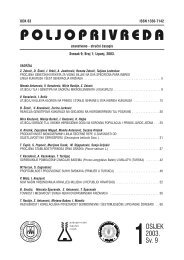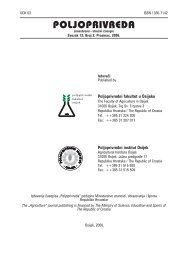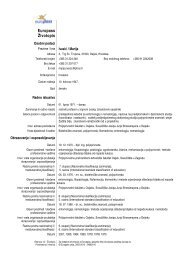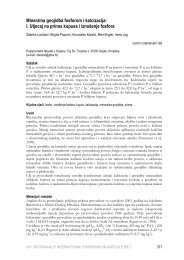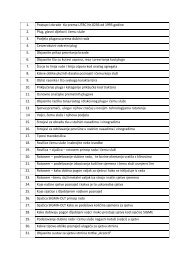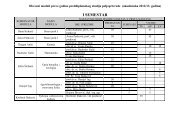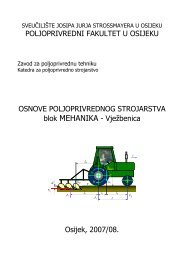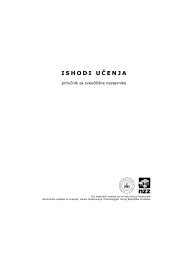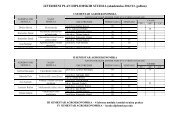1 THE GENERAL APICULTURAL SITUATION OF TURKEY ...
1 THE GENERAL APICULTURAL SITUATION OF TURKEY ...
1 THE GENERAL APICULTURAL SITUATION OF TURKEY ...
You also want an ePaper? Increase the reach of your titles
YUMPU automatically turns print PDFs into web optimized ePapers that Google loves.
ISSN 1330-7142<br />
UDK = 638.1(560)<br />
<strong>THE</strong> <strong>GENERAL</strong> <strong>APICULTURAL</strong> <strong>SITUATION</strong> <strong>OF</strong> <strong>TURKEY</strong><br />
R. Sirali<br />
Scientific review<br />
Pregledni znanstveni članak<br />
SUMMARY<br />
This review is aimed to investigate the general structure, potential and their some important characteristics of<br />
Turkish beekeeping. Additional, the amount and type of beehives, important apicultural areas, honeybee<br />
products, bee races, migratory beekeeping, feeding technique, bee flora, disease and pests, main problems and<br />
some effected factors on apicultural yield were presented and their solutions suggested.<br />
Key-words: beekeeping, bee products, Turkey<br />
INTRODUCTION<br />
Beekeeping has been popular in Turkey, since the ancient times of Anatolian civilizations, Anatolian<br />
Turks Principalities, Seljuk’s and Ottoman States. Turkey has only a short history of beekeeping after<br />
the introduction of modern apiculture and the problems occuring from the environment in each area<br />
have not been identified and solved.<br />
Beekeeping sector has developed very fast after World War II in Turkey. Beekeeping is possible<br />
within the all seven geographical regions of Turkey. Climatic and environmental conditions are always<br />
very suitable to practice the art of bees rearing. Just now, about 4.3 million honeybee colonies there<br />
are supposed to be in Turkey.<br />
Today in our country, we have 40 000 professional beekeepers. Most of these beekeepers are teachers,<br />
farmers, retired, religious leaders or other jobs. Since, beekeeping is the most important income source<br />
over 200 000 families in Turkey.<br />
Even today the beekeepers in Turkey gain the experiences from their forefathers. But basically we do<br />
not have many professionals. Most of our beekeeping is supplementary to other activities done by<br />
people in rural areas.<br />
Unfortunately, Turkey has lagged behind other nations in the systematic use of honeybees to enhance<br />
pollination in order to improve crop yield and quality. The irony is that Anatolia region does have a<br />
very large bee industry focused on honey production. This honeybee potential is based on its<br />
utilization of many different Apis mellifera races and ecotypes, which are native to Anatolia and<br />
Thrace peninsulas.<br />
The aim of this present review was to investigate the general apicultural potential and some of their<br />
important characteristics of Turkish beekeeping.<br />
Important Apicultural Areas<br />
Every different region of Turkey has specific beekeeping and climatic condition, flora and<br />
management. Most of the beekeeping in Turkey takes place in Black Sea, Aegean, Eastern and Center<br />
Anatolian, Marmara and Southeastern Anatolia regions.<br />
Very important honey production districts in Turkey are high plateaus of Kars, Erzurum, Bitlis,<br />
Kayseri, Tunceli, Agri, Yozgat, Sirnak, Batman, Hakkari, Bingol, Van, Mus, Gumushane, Artvin,<br />
Giresun, Rize, Erzincan, Bayburt, Adiyaman, Malatya, Sivas cities, Cukurova, Harran, Ergene and<br />
________________<br />
Ph.D Redžep Sirali, Assistant Professor – Karadeniz Technical University, Ordu Agricultural Faculty,<br />
Department of Animal Science, 52100 Ordu, Turkey.<br />
1
Menderes plains, Karacadag, Anzer, Ovit, Sultanmurat, Alucra, Camoluk, Zigana, Sahara, Sarıbulut,<br />
Santa, Toros mountainous areas and northern area of Thrace.<br />
Most of the beekeeping in Turkey takes place in Mugla, Ordu, Adana, Izmir, Antalya, Aydin,<br />
Erzurum, Sivas, Konya, Kars, İcel and Ankara cities.<br />
Amount and Type of Bee Hives<br />
Turkey has great beekeeping potential of over 4.3 million beehives. Turkey, counting about five bee<br />
colonies per km 2 , is one of the countries with the highest density of beehives in the world (Table 1).<br />
Table 1. Number of colonies in Turkey<br />
Tablica 1. Broj košnica u Turskoj<br />
Year<br />
Godina<br />
1935 1095000 100.00 800 100.00 1895000 100.00<br />
1945 1000369 91.66 26489 3311.13 1026855 54.19<br />
1955 1167525 106.62 113529 14191.13 1281054 67.60<br />
1965 1320969 120.64 299487 37435.88 1620456 85.51<br />
1975 1054656 96.32 918628 114828.50 1973284 104.13<br />
1985 645142 58.92 1940161 242520.13 2585303 136.43<br />
1995 214594 19.60 3701444 462680.50 3916038 206.65<br />
1999 182266 16.65 4139430 517428.75 4321696 228.06<br />
Source: Statistical Indicators, State Statistical Institute of Turkey (DIE), Ankara, 2000<br />
Izvor: Statistički Pokazatelji, Državni statistički instıtut Turske (DIE), Ankara, 2000.<br />
The numbers of honeybee colonies in northern and western areas are larger than other regions of<br />
Turkey. Only about 14 percent of total beehives of Turkey are in Mugla city (Aegean region) and 8<br />
percentages in Ordu city (Black Sea region). Nearly half of our colony numbers are considered to be<br />
subject for migratory beekeeping.<br />
Most beekeepers have langstroth hives in Turkey. Only about 4.2% of total beehives are been still kept<br />
in traditional hives. Many beekeepers of Central Anatolian region generally use the cylindrical hives<br />
made from wood branches covered by mud. In the northern region of Anatolia, beekeepers use<br />
traditional log hives. Wood box hives are used in many districts of South-eastern Anatolia. The<br />
average quantity of collected honey is 2 to 5 kg per hive.<br />
In many districts of Marmara and Central Anatolian regions, some people deal with traditional<br />
beekeeping; they still use ancient styled beehives made of Salix ssp. branches covered by mud with<br />
straw and manure. They can get as many as 3-5 kg honey from a hive during the honey flow period.<br />
All traditional beehives are called Turkish “karakovan” or “sepetkovan” (primitive hive). As a result,<br />
honey yields of traditional beehives in Turkey are low generally. However, products of all these<br />
traditional hives are more expensive than modern bee hives.<br />
Bee Races<br />
Old type<br />
Stari tip<br />
Index<br />
Indeks<br />
1935=100<br />
Modern type<br />
Moderni tip<br />
Index<br />
Indeks<br />
1935=100<br />
Total<br />
Ukupno<br />
Index<br />
Indeks<br />
1935=100<br />
Turkey has many different kinds of topographic and climatic characteristics. As a result of this<br />
heterogeneous ecological structure, the honeybee has spread widely throughout Anatolia and Thrace,<br />
where it has differentiated into several forms. It is evident that there is much greater honeybee<br />
diversity in Turkey than in most other countries<br />
There are different bee races and ecotypes in Turkey, e.g. Apis mellifera caucasica (North east of<br />
Turkey), Apis mellifera anatoliaca (Central Anatolia) and their ecotypes such as Mugla, Gokceada<br />
Island, Marmara and Karadeniz. Each honeybee race and ecotype reflects in its morphology and<br />
behaviour environmental characteristics of its endemic range.<br />
The first important bee centre of Turkey is Central Anatolia. Apis mellifera anatoliaca bee, and well<br />
known as the Anatolian honeybee is the characteristic bee race of Anatolia. The honeybees of the<br />
2
Central Anatolia, with several subpopulations in the north, west and south, while Apis mellifera<br />
caucasica is considered as the honeybee of the mountain range bordering the northeast region of<br />
Anatolia. The most common ecotypes of Apis mellifera anatoliaca are the Mugla and the Central<br />
Anatolian bees.<br />
Apis mellifera anatoliaca is the most common bee in Turkey. They are very aggressive honeybees.<br />
They have many ecotypes adapted to different regions and showing great variation in terms of body<br />
colour, productivity, and specific morphological, physiological characters.<br />
Second important honeybee race of Turkey is Apis mellifera caucasica. The Caucasian bees are grey<br />
dark colored, gentle and productive bees with low swarming tendency and adapted to highlands and<br />
temperate climates. Therefore they collect much propolis, their spring development is slower than the<br />
other races but they build up strong colonies during the summer and produce much honey. They tend<br />
to rob the weak colonies.<br />
Same apicultural scientists considered that local honeybee of South-eastern Anatolia can be to Apis<br />
mellifera syriaca or Apis mellifera meda. General characters of honeybees in Southeastern Anatolian<br />
conditions are small colonies, relatively small quantity of honey storage, more aggressive than other<br />
honeybee races or ecotypes of Turkey, easily swarming. These characters are well fit to the fluctuating<br />
hot conditions to live, but not suitable for beekeeping sector.<br />
Nowadays, there are some different ideas about identifying the Thracian honeybees in Turkey. Some<br />
scientists describe Thracian bees as ecotypes of Apis mellifera anatoliaca or Apis mellifera carnica<br />
All these races and ecotypes are raw material for breeding studies. This genetic diversity represents the<br />
key element for Turkish scientist to lead the world in the development of crop-specific and taskspecific<br />
vector for the future.<br />
Bee Flora<br />
We produce flower honey mainly from cultivated plants, such as oranges (Mugla, İzmir, Antalya,<br />
Mersin, Adana, Hatay), cotton (Mardin, Diyarbakir, Sanliurfa, Gaziantep, Adana, Aydin, Nazilli,<br />
Izmir), sunflower (Istanbul, Tekirdag, Kirklareli, Edirne, Balikesir, Canakkale, Samsun, Aksaray,<br />
Yozgat, Adana), heather (Canakkale, Tekirdag, Kırklareli, İstanbul, Mersin, Tarsus ), chestnut<br />
(Trabzon, Giresun, Samsun, Rize, Sinop, Kastomonu, Bolu, Bursa, Canakkale, Balıkesir), linden trees<br />
(Tekirdag, Kırklareli, İstanbul ), as well as from different orchards. Wild Nectar yielding plants in the<br />
all regions of Turkey are clovers, acacia, raspberries, strawberry, bee balms etc.<br />
Our country has o lot of pollen yielding plants as almond trees (Amigdalus), Castanea sativa,<br />
Castanea vulgaris, Salix alba, Robinia pseudoacacia and Erica. Special importance goes to the last<br />
mentioned plant known by some honey lovers as a beaming health agent.<br />
Colonies foraging on forest plants, especially on Pinus trees (the Germans call the resulting honey<br />
“Waldhonig”), yield about 20% of our honey production. In this particular case, honey is being<br />
produced from honeydew of the insect Marchalina hellenica (Monophlebus hellenicus). Bee colonies<br />
are transported from all parts of the Turkish country to the lavish pine forests, found mainly on the<br />
Marmara’s islands (Büyükada and Heybeliada), on the peninsula of Aegean (Mugla, Fethiye, Denizli,<br />
Izmir, Edremit) and in Mediterranean region (Antalya). September and October are the most plentiful<br />
months.<br />
Significant amounts of honeydew honey derived from the Papaver, Carduus, Rosa, Tilia, Salix,<br />
Quercus, Castenea, Populus, Betula, Tamarix, Ulmus, Picea, Prunus, Pyrus and Malus<br />
Evident amounts of honeydew honey derived from the Abies trees in Marmara region and on the<br />
Uludag mountains situated about 500 km north east of Ankara and 300 km south of Istanbul. This<br />
honey is being produced from honeydew of the insect Lachnus ssp.<br />
Our world famous thyme honey, its renown, being due to its excellent flavour and richness in<br />
enzymes, constitutes a rather limited percentage of the annual honey production in Turkey. It comes<br />
from the Central Anatolia, Aegean, Black Sea and Marmara regions.<br />
Black Sea region is known the most popular and most precious variety of honey made by high plateau<br />
plants of Anzer. This product is more expensive than other honey districts of Turkey. It has specific<br />
colour, taste and strong elegant smell of Anzer high plateau plants. These plants only flowers at the<br />
end of June, beginning of August. So these bees have to make haste, being their unique opportunity to<br />
collect nectar.<br />
3
In addition, toxic honey (the Turks call the resulting honey “Deli bal=Crazy honey”, production<br />
derived in September and October from the Rhododendron ponticum that takes place in the northern<br />
mountains areas in Turkey. This area stretches from east to west parallel to the Black Sea and is<br />
bordered upon the east by the Central Anatolia.<br />
Migratory Beekeeping<br />
Migratory beekeeping style is very common and predominates in Turkey. This means that the hives<br />
have to be moved from one place to another searching for ultimate good quality honey in reasonable<br />
quantities.<br />
Migratory beekeeping, in which beekeepers move from north to south and from east to west following<br />
the blooming of honey plants, is not so popular at present because of the several reasons: aging of<br />
beekeepers, decreasing honey plants and large scale beekeepers.<br />
The honey bee colonies are transferred in spring to the citrus groves and thyme areas, in June to the fir<br />
forests, in summer to the cotton, clover and sunflowers plants and in August, September and October<br />
to the vast pine forests in the country generally.<br />
Professional beekeepers have about 100-400 bee colonies, sometimes up to 1000. They transport their<br />
hives extensively during the year; up to distances of 2000-4000 km. Eighty percentage of total<br />
migratory beekeepers of Turkey are from Ordu, a Black Sean city.<br />
As a consequence, the migratory beekeeping technique is improving. But, the genetic structure of the<br />
Turkish bee population is becoming homogenized and genetic variation is getting lost.<br />
Honeybee Products<br />
Although the main commodities are honey, beeswax, pollen, propolis, royal jelly, bee venom, queen<br />
and package, bees can also be produced from beekeeping activities.<br />
Beekeeping and its all products has important role in history of Turkish society and trade life. Thus<br />
almost all of bee products are useful to humans. Honey is the most important product of the<br />
beekeeping sector of Turkey. Seventy percentages of total honey production of Turkey is sold as comb<br />
and 30 percentages as extracted.<br />
According to the statistics of the State Statistical Institute of Turkey (DIE), honey production was<br />
67259 tons in 1999. Although the honey yield increases every year steadily, this increase is not<br />
satisfactory (Table 2). Turkey has only 5.7% of world honey product. One of the main reasons for the<br />
low honey yield is the insufficient queen bee production in the country.<br />
Table 2. Honey production in Turkey<br />
Tablica 2. Proizvodnja meda u Turskoj<br />
Years<br />
Godine<br />
Honey production (tons)<br />
Proizvodnja meda (t)<br />
Index<br />
Indeks<br />
1935=100<br />
Average production kg / hive<br />
Prosječna proizvodnja (kg/ košnici)<br />
Index<br />
Indeks<br />
1935=100<br />
1935 4338 100.00 2.29 100.00<br />
1945 3671 84.62 3.57 155.90<br />
1955 7111 163.92 5.55 242.36<br />
1965 10320 237.90 6.37 278.17<br />
1975 21250 489.86 10.77 470.31<br />
1985 35840 826.19 13.86 605.24<br />
1995 68620 1581.83 17.52 756.07<br />
1999 67259 1550.46 15.56 679.48<br />
Source: Statistical Indicators. State Statistical Institute of Turkey (DIE), Ankara, 2000<br />
Izvor: Statistički pokazatelij. Državni statistički instıtut Turske (DIE), Ankara, 2000.<br />
The annual honey production is estimated to be around 15.6 kg per colony, although values of about<br />
35-40 kg per colony are usual for professional beekeepers. Eighty percent of total honey of Turkey is<br />
produced by migratory beekeepers.<br />
4
While product quality usually differs among producers, there is general tendency of treating the<br />
products from the same areas as having the same quality. Generally, the marketability of products is<br />
mostly limited to the retail, domestic market and the international trade tends to be restricted of honey.<br />
Prices of all honeybee products are far the most important factor in competition; but capital investment<br />
is not so active in the beekeeping sector.<br />
Turkey’s pine honey production is very famous in the world. More than 90% of domestic production<br />
of pine honey was sold via exports, mostly those to European and Middle East countries every year.<br />
Exportation of honey of Turkey was nearly 5000 tons last years. This brought approximately $ 10<br />
million gain being the most important trade factor of our country. The value of honey export is<br />
variable every year (Table 3).<br />
Table 3. Honey Export of Turkey<br />
Tablica 3. Izvoz meda u Turskoj<br />
Year<br />
Godina<br />
Honey export (tons)<br />
Izvoz meda (t)<br />
Index<br />
Indeks<br />
1936=100<br />
Export value (1000 $)<br />
Izvozna vrijednost (1000 $)<br />
Index<br />
Indeks<br />
1963=100<br />
1963 4 100.00 3 100.00<br />
1965 2 50.00 1 33.33<br />
1975 54 1350.00 69 2300.00<br />
1985 2176 54400.00 4050 135000.00<br />
1995 2934 73350.00 6759 225300.00<br />
1999 5306 132650.00 9996 333200.00<br />
Source: Honey Export of Turkey. www. fao.org.<br />
Izvor: Izvoz meda Turske. www. fao.org.<br />
The domestic output of beeswax is about 4073 tons. According to the statistics of the State Statistical<br />
Institute of Turkey (DIE), the wax production of the different years is given in Table 4.<br />
Table 4. Wax production in Turkey<br />
Tablica 4. Proizvodnja voska u Turskoj<br />
Years<br />
Godine<br />
Wax production (tons)<br />
Proizvodnja vosak (ton)<br />
Index<br />
Indeks<br />
1936=100<br />
Average production kg / hive<br />
Prosječna proizvodnja kg/ košnici<br />
Index<br />
Indeks<br />
1936=100<br />
1935 602 100.00 0.32 100.00<br />
1945 412 68.44 0.40 125.00<br />
1955 844 140.20 0.66 206.25<br />
1965 1.144 190.03 0.71 221.88<br />
1975 1.712 284.39 0.87 271.88<br />
1985 2.196 364.78 0.85 265.63<br />
1995 3.735 620.43 0.95 296.88<br />
1999 4.073 675.58 0.94 293.75<br />
Source: Statistical Indicators. State Statistical Institute of Turkey (DIE), Ankara, 2000<br />
Izvor: Statistički pokazatelij. Državni statistički instıtut Turske (DIE), Ankara, 2000.<br />
The DIE statistics show that about 4073 tons of wax were produced in Turkey and it can be supposed<br />
that almost all of the raw materials were sold on the market used for honey comb production.<br />
Other bee products of Turkey (pollen, royal jelly, bee venom and propolis) have important role in our<br />
beekeeping industry. Trading amount of honeybee colonies of Turkey are nearly 40000-50000 units<br />
annually.<br />
According to the annually statistics of the ministry of Agriculture of Turkey, the value of honey<br />
production was $ 150 million, producing queens and bees for sale to other beekeepers $ 36 million and<br />
other bee products (pollen, propolis and royal jelly) $ 2.9 million in 1999.<br />
Moreover, bees pollinate the flowering plants while collecting nectar and pollen thus increase the<br />
quality and quantity of cultivated crop plants enabling the wild flowers and many plants to survive.<br />
5
In Turkey, the added value in agriculture from honeybee pollination is over $ 2.3 billion annually,<br />
however, beekeepers do not earn extra income from transport of their colonies for pollination.<br />
Diseases and Pests<br />
Some well-known diseases and pests, such as the Varroa mite and chalk brood as well as the abundant<br />
use of pesticides in agriculture and frequent fires in the woods, cause serious problems to our<br />
beekeepers.<br />
The Varroa mite was first recorded in Turkey in 1976, close to the Bulgarian and Greek Borders in<br />
Thrace, and from Russian border to the Northeastern Anatolia in 1980. Shortly afterwards, late that<br />
same year, the dangerous mite was found in some other areas like Marmara, Central Anatolia, Eastern<br />
Anatolia, Black Sean, Aegean and Mediterranean regions.<br />
There is a slight decline in the infection rate of chalk brood (Ascosphaera apis) but it can be endemic<br />
again any time as happened to be in other countries.<br />
The chalk brood disease is the other important problem of Turkish beekeeping, too. This disease was<br />
first recorded in 1986 in Turkey. Nowadays the diseases and pests can be found in beehives all over<br />
the country. Because of this, it is hard to increase the number of beehives.<br />
Transfer of the beehives to other places spread the parasites and gave serious damage in the new area,<br />
in Turkey after 1980. In addition, migratory beekeeping practise can be considered as having been the<br />
main course of the present dramatic Varroa mite and chalk brood situation in Turkey.<br />
We have no accurate official data on the losses of colonies, except for the period 1978-1988.<br />
According to the Turkish beekeepers, it is estimated that 20-30% of the colonies were severely<br />
damaged or totally destroyed by the Varroa and chalk brood.<br />
Similarly, the spread of American foulbrood (Paenibacillus larvae) and nosematosis (Nosema apis)<br />
are increasing countrywide. Other important diseases and pests of Turkey are nosema, foulbrood, wax<br />
moths, tracheal mites and wasp. All these diseases and pests lower the population growth of the bees,<br />
weaken the colonies and decrease the production of honey and other bee products.<br />
Beekeepers use many pesticides. Thus, Varroatosis is now under control by using effective acaricides<br />
against it. Active ingredients of this effective acaricides are Caumaphos, Asuntal, Flumethrin,<br />
Amitraz, Malathion, Bromopropylat, Cymiazol, Fluvalinate, Formic Acid and others. However vast<br />
and overdose use of these pesticides, effectiveness of these chemicals decreased, mites become<br />
resistant to these pesticides in the colonies and residue become a major problem due to inappropriate<br />
or misuse of these chemicals. Moreover, the bees became more susceptible to the bacterial viral and<br />
fungal diseases due to Varroa infections. Up to now, no registered drug exists in Turkey against chalk<br />
brood.<br />
Application of some chemicals (antibiotics, pesticides etc.) sometimes causes the residue problems<br />
affecting the quality of some hive products. Extension education of beekeepers about the application<br />
of the chemicals is poor. For this reason it cannot be controlled in general.<br />
Feeding Method<br />
Generally government controls sugar prices being lower than that of honey. Because of this, bees can<br />
be fed enough sugar syrup and are not liable to cause robbing. This situation may not result in the<br />
spread of diseases and harmful mites. Keeping bees requires the feeding them sugar syrup to promote<br />
the building up of colonies or to keep them healthy during the season when resources are scarce.<br />
Bees in central, northern and eastern areas spend five to six winter months without hibernation and<br />
thus need large quantities of honey. The amount of honey stored by Turkish bees differs according to<br />
the size of their colonies but should be at least 5 to 20 kg at the time when they start hibernation.<br />
Main Problems of Beekeeping in Turkey<br />
Turkish beekeeping face the same problems as anywhere else in the world. Our beekeeping has a<br />
variety of problems to be dealt with. Among them we can say the main problems are: the biological<br />
6
problems of bees, climate and other natural features, relations to environmental factors, beekeeping<br />
techniques, the quality of products and problems in marketing and trading.<br />
There are several problems such as existence of honeybee diseases and pests, keeping old and<br />
unproductive queens in colonies, apicultural equipments and supplies, education of beekeepers,<br />
nutrition and management, disease and pests, lack of knowledge of beekeepers in many aspects of<br />
beekeeping and lack of organisation among the beekeepers.<br />
In order to solve these problems, a queen bee production centre should be established, beekeepers<br />
should be trained on the diagnosis and treatment of honeybee diseases and technical beekeeping. Also,<br />
they should be encouraged to have beekeeping organisations such as associations or cooperatives. As a<br />
result, some measures should be taken to promote this re-education of beekeepers.<br />
Retraining beekeepers is important for product quality improvement and better distribution as well as<br />
for better beekeeping technology development.<br />
CONCLUSION<br />
Turkey has great beekeeping potential having very rich flora and suitable ecology that unfortunately<br />
has not been utilised properly. Total honey production, honey yield and production of other bee<br />
products are rather low and it is possible to increase them twice or thrice. Some of the reasons for low<br />
yield are the widespread of bee diseases and parasites, insufficient queen production, educational level<br />
and knowledge of beekeepers, as well as lack of beekeeping organisations.<br />
REFERENCES<br />
1. Anonymous (1986): Aricilik. Ana Britannica. İstanbul, 274-275.<br />
2. Cakmak, I. (1999): Honeybees and Agriculture. May Agro-Tek. Bursa, 3(7): 7-9.<br />
3. Darendelioglu, Y., Kence, A. (1992): Morphometric Study on Population Structure of Middle<br />
Anatolia Honey Bee (Apis mellifera L.) (Hymenoptera, Apidae). The Second Turkish National<br />
Congress of Entomolgy. Adana, 387-396.<br />
4. Delaplane, K.S. (1999): Honey Bees and Beekeeping. The University of Georgia, College of<br />
Agricultural and Environmental Sciences, Athens, Georgia.<br />
5. Genc, F. (1993): Ariciligin Temel Esaslari. Atatürk Universitesi Ziraat Fakultesi Yayin, No. 149,<br />
Erzurum, 138–185.<br />
6. Güler, A., Korkmaz, A., Kaftanoğlu, O. (1999): Reproductive Characteristics of Turkish<br />
Honeybee (Apis mellifera L.) Genotypes. Hayvansal Uretim. Izmir. 39-40: 113-119.<br />
7. Infandites, M. (1990): Beekeeping in Greece. Bienenstich, No 17, Ciba-Geigy AG, Basel.<br />
8. Kaftanoglu, O. (1998): National Beekeeping Development Project. Cukurova University,<br />
Agricultural Faculty, Department of Animal Sciences, Adana.<br />
9. Kaftanoglu, O. (2001): The Concept of Honey Bee Races and Race Preference. Uludag Bee<br />
Journal. Bursa, 1(3):11-20.<br />
10. Nakamura, J. (1999): Problems of Beekeeping in Asia. Farming Japan, Vol. 33-3, 15-17.<br />
11. Sahinler, N., Sahinler, S. (1996): A Study on the Present Situation and Problems of Apiculture and<br />
Some Recommendation in Hatay Province. Journal of Agricultural Faculty of Mustafa Kemal<br />
University, 1(1):17-28.<br />
12. Santas, L.A. (1990): The dangerous mite plagues Grecien bees, Varroa spread rapidly.<br />
Bienenstich, No 17, Ciba-Geigy AG, Basel.<br />
13. Sasaki, M. (1999): Ecological Characteristics of Asiatic Hive Bee and its possibility as Apicultural<br />
Species. Farming Japan, Vol. 33-3, 18-22.<br />
OPĆA PČELARSKA SITUACIJA U TURSKOJ<br />
SAŽETAK<br />
U ovom radu istražuje se opća struktura, potencijali i neke važne značajke turskog pčelarstva. Prikazani su<br />
broj i tipovi košnica, važne pčelarske regije, pčelarski proizvodi, pasmine pčela, selidbeno pčelarstvo, tehnika<br />
7
hranjenja, medonosno bilje, bolesti i nametnici pčela, glavni problemi u pčelarskoj proizvodnji, neki<br />
čimbenici koji utječu na prinos u pčelarstvu te prijedlozi mjera za njihovo rješavanje.<br />
Ključne riječi: pčelarstvo, pčelinji proizvodi, Turska<br />
(Received on 14 March 2002; accepted on 9 July 2002 – Primljeno 14. ožujka 2002.; prihvaćeno 9. srpnja<br />
2002.)<br />
8



